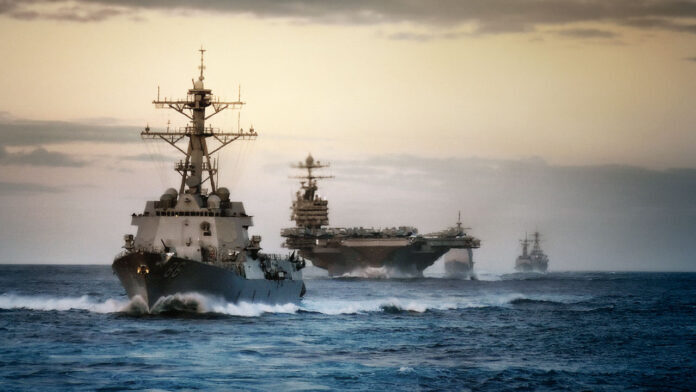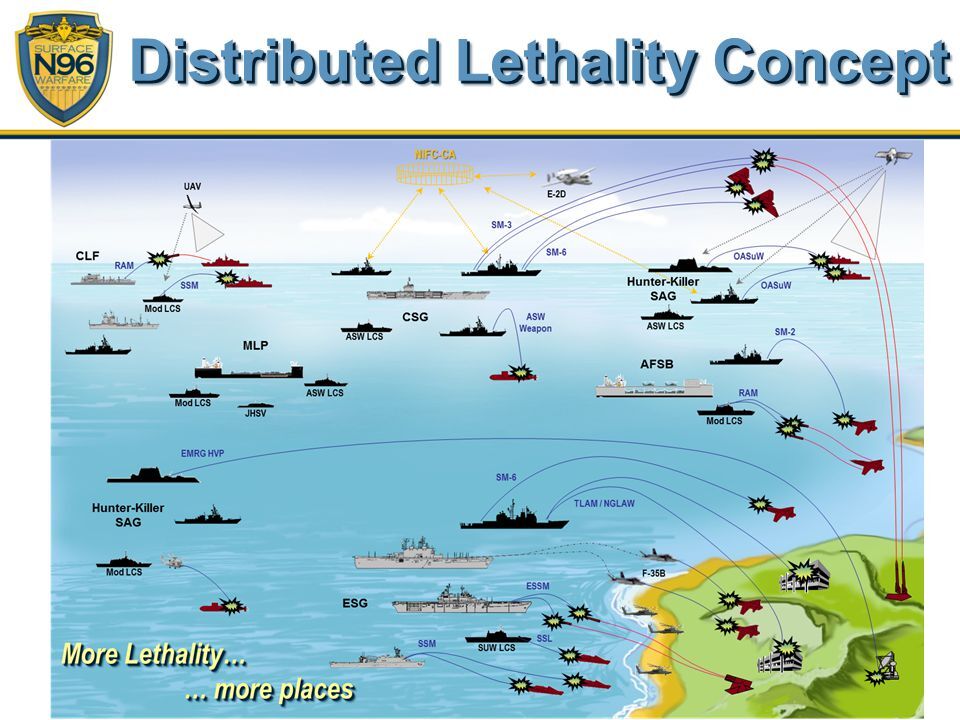"분산 치사율" 개념이란 무엇입니까?
Raymond McConolly 작성 - 2021년 6월 23일
분산된 치사율
사진 제공 미 해군
분산된 치사율은 공격 수상 전투의 최신 패러다임 전환이 될 것입니다.
해상 수상전은 급격한 기술 및 작전 변화의 시기를 겪고 있습니다. 냉전 종식 이후 거의 30년 동안 해군은 상대적으로 관대한 환경에 직면했으며 개선된 방어 시스템은 그들이 직면한 위협을 크게 물리칠 수 있었습니다. 그러나 유비쿼터스 수동 센서, 저소음 잠수함, 초음속 및 극초음속 대함 미사일(ASM), "스마트" 기뢰, 해군 작전에서 준군사 부대의 사용 증가를 포함하여 새로운 세대의 도전 과제가 등장했습니다. 그 결과 많은 함대가 대공방어, 대잠수함전(ASW), 해상 및 지상공격, 기뢰전(MIW)과 같은 전통적인 수상 임무에 대한 개념과 능력을 수정하고 있습니다.
DL(Distributed Lethality)은 2015년 1월 미 해군 연구소의 USN 기장 3명이 공동으로 작성한 기사에서 USN이 개발 중인 개념으로 공식 발표했습니다. 이 기사는 " 미묘하지 않고 … 우발적이지 않습니다.” Admirals는 바다에 대한 경쟁 없는 통제에 의존하는 항공모함 기반 전술의 지배로 인해 수상 함대의 핵심 기술과 역량의 상실을 언급했습니다.
본질적으로 USN은 냉전 종식 후 해양 영역의 지배에 익숙해졌습니다. 그 결과 대잠전(ASW) 및 대수상전(ASUW)과 같은 핵심 임무를 수행하는 수상함의 능력이 위축될 수 있었습니다. 적의 통제 지역에서 멀리 떨어진 비경쟁 수역에서 항공모함을 보호하는 것이 USN의 유일한 초점이 되었습니다. 이 문제를 해결하기 위해 제독은 Distributed Lethality를 고안했습니다.
분산 치명성 개념 - 해군 사후 해군 뉴스 및 정보
분산된 치사율 개념 – 미 해군 출시
미 해군의 미래 작전 개념
DL(Distributed Lethality) 개념은 접근 방지 및 거부(A2/AD) 환경에서 미국 함대의 생존력과 공격 능력을 향상시키기 위해 개발되고 있습니다. 냉전 종식 이후 미국은 압도적인 군사력으로 거의 모든 전장을 장악했습니다. 그러나 장거리 미사일 개발을 포함한 적의 A2/AD 능력 증대는 미국의 행동의 자유를 위협하고 있다.
또한 Distributed Lethality는 SAG(Hunter-Killer Surface Action Group)라는 부대를 지리적으로 분산하여 적이 미군을 표적으로 삼는 것을 어렵게 만들 계획입니다. 미 해군은 DL 개념이 합동군 사령관(JFC)에 더 많은 공격 옵션을 제공하고 주도권을 장악하며 적의 복잡성을 증가시킬 것으로 기대합니다.
바다 통제가 주요 초점입니다.
DL 개념은 해상 통제를 확립하고 적이 동일한 일을 하는 것을 방지하는 것입니다. 이는 개별 전함의 공격 및 방어 능력을 높이고 광활한 지리에 걸쳐 분산된 대형에 배치하고 분산된 화력을 생성함으로써 달성됩니다. 강력한 방어 시스템으로 무장하고 신뢰할 수 있는 수상 발사 격리 무기로 무장한 수상 부대는 경쟁 환경과 통신이 열악한 환경 모두에서 생존할 수 있어 해상 영토를 확보하고 후속 전력 투사 작전을 위해 병력이 흐를 수 있도록 합니다. 해상 통제는 항상 모든 바다를 지휘하는 것을 의미하지 않습니다. 그 대신, 다른 목표를 가능하게 하고 그러한 목표를 달성하는 데 필요한 기간 동안 바다를 유지하는 것이 필요할 때와 장소에서 바다에 대한 국지적 통제를 부과하는 능력과 능력입니다.
Distributed Lethality는 전술 및 작전 수준에서 구별되는 특성을 가지고 있습니다. 전술적 수준에서 유닛의 치사율을 높이고 탐지 및 표적화에 대한 군함의 취약성을 감소시킵니다. 작전 지향적이며 작전 수준에서 광범위하게 분산된 작전을 수행할 수 있는 공격적 적응형 부대 패키지의 요소로 군함을 사용합니다. 적응형 부대 패키지를 통해 작전 지휘관은 위협 수준에 따라 부대 능력을 확장할 수 있습니다. 이러한 고용 방식은 전장을 개방하고 은폐와 기만을 가능하게 하여 적의 표적에 불확실성과 복잡성을 주입하도록 설계되었습니다.
분산된 치사율 - 해군 사후 해군 뉴스 및 정보
미해군 이미지
헌터 킬러 SAG
USN의 초점은 기존 CVN 전투 그룹을 지원하는 데 필요한 기술을 유지하면서 공격으로 다시 이동합니다. 분산 치명타는 수상함대의 개별 구성 요소(순양함, 구축함, 연안 전투함[LCS], 상륙함 및 물류 선박)의 공격력을 증가시킨 다음 "헌터- 살인자 SAG." 난로 무장
What is the “Distributed Lethality” Concept?

Distributed lethality is to become the newest paradigm shift in offensive surface combat
Naval surface warfare is undergoing a period of rapid technological and operational change. During the nearly 30 years since the end of the Cold War, navies encountered relatively permissive environments, and improved defensive systems could largely defeat the threats they did face. However, a new generation of challenges has emerged, including ubiquitous passive sensors, quiet submarines, supersonic and hypersonic anti-ship missiles (ASM), “smart” mines, and the increasing use of paramilitary forces in naval operations. As a result, many fleets are revising their concepts and capabilities for traditional surface missions such as air defense, anti-submarine warfare (ASW), maritime and land strike, and mine warfare (MIW).
Distributed Lethality (DL) was officially announced as a concept in development by the USN in an article jointly written by three USN flag officers for the United States Naval Institute in January 2015. The piece referred to a shift underway in the surface force that was “not subtle, and … not accidental” The Admirals referred to the loss of core skills and competencies in the surface fleet due to the dominance of carrier-based tactics that relied upon uncontested control of the sea.
Essentially the USN had become accustomed to the domination of the maritime domain following the end of the Cold War. As a result, the ability of surface ships to conduct core duties such as anti-submarine warfare (ASW) and anti-surface warfare (ASUW) had been allowed to atrophy. Protecting carriers in uncontested waters far from enemy-controlled areas had become the sole focus of the USN. To correct this problem, the admirals have come up with Distributed Lethality.

U.S. Navy’s future operation concept
The Distributed Lethality (DL) concept is the that is being developed to enhance the viability and offensive capabilities of the U.S. fleet in an Anti-Access and Anti-Denial (A2/AD) environment. Since the end of the Cold War, the United States has dominated almost every battlefield with its overwhelming military power. However, the increased A2/AD abilities of the enemy, including the development of long-range missiles, threaten the freedom of action of the United States.
Additionally, Distributed Lethality plans to geographically distribute forces called a Hunter-Killer Surface Action Group (SAG), making it challenging for the enemy to target U.S. forces. The U.S. Navy expects the DL concept to provide more attack options to Joint Force Commanders (JFC), seize the initiative, and increase complexity for the enemy.
Sea Control is the main focus
The DL concept is to establish sea control and prevent an adversary from doing the same. It is achieved by increasing the offensive and defensive capability of individual warships, employing them in dispersed formations across a vast expanse of geography, and generating distributed fires. Surface forces outfitted with robust defensive systems and armed with credible surface-launched stand-off weapons, survivable in both contested and communications degraded environments, will help to secure sea territory and enable forces to flow for follow-on power projection operations. Sea control does not mean command of all the seas, all the time. Instead, it is the capability and capacity to impose localized control of the sea when and where it is required to enable other objectives and to hold it as long as necessary to accomplish those objectives.
Distributed Lethality has distinguishing characteristics at the tactical and operational levels. At the tactical level, it increases unit lethality and reduces the susceptibility of warships to detection and targeting. It employs warships as elements of offensive Adaptive Force Packages that are task-oriented and capable of widely dispersed operations at the operational level. Adaptive Force Packages allow operational commanders the ability to scale force capabilities depending on the level of threat. This manner of employment is designed to open battlespace and enable concealment and deception to inject uncertainty and complexity into an adversary’s targeting.

Hunter-killer SAGs
The focus of the USN will shift back to the offensive while maintaining the skills required to support existing CVN battle groups. Distributed Lethality is the condition gained by increasing the offensive power of individual components of the surface force (cruisers, destroyers, littoral combat ships [LCSs], amphibious ships, and logistics ships) and then employing them in dispersed offensive formations known as “hunter-killer SAGs.” Arming the overall fleet with longer-range weapons has been a significant focus for the Navy for many years. For example, arming the LCS with deck-launched Hellfire missile to extend ship-based air-defense ranges and giving the ship the new “over-the-horizon” NSM missile, the strategy also employed on the Navy’s new Frigate, emerged years ago as part of the Distributed Lethality concept.

Hunter-killer SAGs seize maritime operations areas for subsequent activities (including power projection), perform screening operations for more giant formations, and hold adversary land targets at risk. Additionally, by distributing power across a more significant number of more geographically spaced units, adversary targeting is complicated, and attack density is diluted. Hunter-killer SAGS can defend themselves against air and missile attacks and extend that protection to expeditionary forces conducting offensive operations of their own. These hunter-killer SAGs will be networked and integrated to support complex operations even when not supported by the carrier air wing and land-based patrol aircraft.
Limitations of Distributed Lethality
However, there are many limitations in realizing this concept. It is practically difficult to cover the vast A2/AD area by the United States alone. There is a high probability that logistical support problems will also occur in dispersed domains due to the lack of adequate logistical support for U.S forces. In other words, with the existing supply system, it would not be able to efficiently cope with the demand for supplies at different times and locations.
Conclusion
As a result, if the problems that can be experienced in logistics and command and control are eliminated, Distributed Lethality provides the ability to apply all elements of sea power for deterrence, to respond to crises, aggression, or conflict, to build readiness to project power to deny or defeat attack in multiple theaters, and to provide a robust ability to strike targets with a surprise from the sea.
Check out Naval Library App to find out the specifications of the US Navy assets.
'공부하기 > military. warfare.' 카테고리의 다른 글
| 모신나강을 가장 쉽게 정리해준 영상. ^^ (0) | 2021.12.05 |
|---|---|
| 상부공격 전차지능탄에 대한 상쇄연구 (0) | 2021.12.03 |
| 작성중-석궁의 장단점과 전세계의 석궁들 (0) | 2021.11.16 |
| 고속도로 휴게소에서 만난 M-48전차. (0) | 2021.11.13 |
| "中, 사막에 美 항모 모형 만들어놓고 미사일 타격 시험" (0) | 2021.11.10 |


댓글